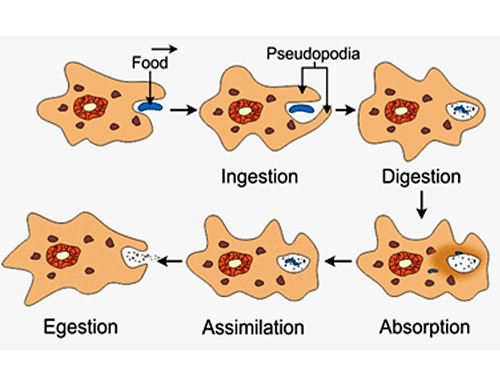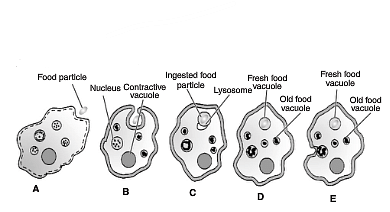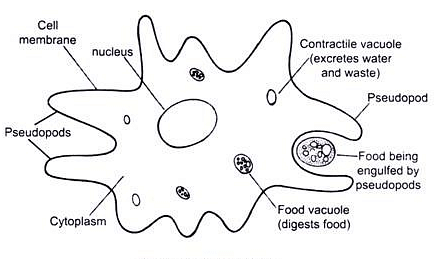Introduction
Holozoic nutrition represents a vital mode of heterotrophic feeding observed in various organisms across the biological spectrum. This comprehensive guide aims to unravel the intricacies of holozoic nutrition, elucidating the processes and mechanisms involved in obtaining nutrients for sustenance.
Step 1: Defining Holozoic Nutrition
Definition of Holozoic Nutrition: Holozoic nutrition is a type of heterotrophic nutrition characterized by the ingestion of complex organic substances, such as other living or dead organisms, to fulfill an organism’s nutritional requirements. This mode of nutrition is notably distinct from autotrophic strategies, as holozoic feeders rely on external sources for obtaining essential nutrients.
Step 2: Holozoic Nutrition in Various Organisms
Holozoic Nutrition in Protozoa: In unicellular organisms like amoeba and paramecium, holozoic nutrition involves the engulfing of prey through processes like phagocytosis. These organisms exhibit remarkable adaptability in capturing and digesting their food within a single cell.
Holozoic Nutrition in Multicellular Organisms: Moving beyond unicellular life, multicellular organisms, including animals, showcase holozoic nutrition through specialized digestive systems. Carnivores, herbivores, and omnivores exemplify diverse approaches to obtaining and processing food in more complex organisms.
Step 3: Mechanisms of Holozoic Nutrition
Ingestion: The process begins with the ingestion of whole food particles, whether plant or animal matter, into the organism’s body. This can involve various strategies, such as capturing prey, grazing on vegetation, or scavenging on decaying matter.
Digestion: Once ingested, the food undergoes mechanical and chemical breakdown through processes like chewing, enzyme secretion, and stomach acid digestion. In unicellular organisms like amoeba, intracellular digestion within specialized vacuoles takes place.
Absorption: After digestion, nutrients are absorbed into the bloodstream or directly into the cell’s cytoplasm, depending on the organism’s complexity. In multicellular organisms, the circulatory system plays a crucial role in transporting nutrients to various cells and tissues.
Assimilation: The assimilation phase involves the utilization of absorbed nutrients for energy production, growth, and maintenance of cellular functions. Cells and tissues use these nutrients to sustain the organism’s overall well-being.
Step 4: Holozoic Nutrition in Humans
Holozoic Nutrition in the Human Diet: Human beings exemplify holozoic nutrition through a diverse and omnivorous diet. The ingestion, digestion, and absorption of nutrients occur in specialized organs of the digestive system, including the mouth, stomach, small intestine, and associated glands.
Holozoic Nutrition and Dietary Choices: Humans, as holozoic feeders, make dietary choices based on nutritional needs and preferences. A balanced diet that includes a variety of foods ensures the intake of essential nutrients required for optimal health.
Additional Information
- Adaptations in Holozoic Feeders: Explore specific adaptations in organisms practicing holozoic nutrition. From the pseudopodia of amoeba to the complex dental structures in carnivores, these adaptations highlight the diversity of strategies employed for successful feeding.
- Comparisons with Other Nutritional Modes: Facilitate a comparative analysis between holozoic nutrition and autotrophic or saprophytic nutrition. Understanding the distinctions in nutritional strategies enhances appreciation for the diversity of life’s feeding mechanisms.
- Ecological Significance: Highlight the ecological significance of holozoic nutrition in various ecosystems. The interactions between holozoic feeders and their prey contribute to the balance and sustainability of food webs.
By navigating through these steps and additional information, individuals can develop a comprehensive understanding of holozoic nutrition, appreciating its significance across diverse organisms and its essential role in sustaining life. This guide serves as a valuable resource for students, educators, and enthusiasts eager to explore the fascinating world of nutritional strategies in the living kingdom.
Process of Nutrition in Amoeba
The process of holozoic nutrition in amoeba is explained in detail in the following steps:
-
Ingestion
Amoeba has no mouth or similar organ for intake of food. So, it engulfs food particles by extending finger-like projections called pseudopodia from its body and then forms a food vacuole. This process of engulfing food is called phagocytosis. Given below is the process of phagocytosis in amoeba.

-
Digestion-
The complex food is broken into small soluble molecules inside the food vacuole. The digestive enzymes present in the surrounding cytoplasm enter the food vacuole and break down the food into small and soluble molecules by chemical reaction for digestion.
-
Absorption-
The cytoplasm of the amoeba directly absorbs the digested food from the food vacuoles by diffusion, while the undigested part is left behind. This process of diffusion of food into the cytoplasm is called absorption. After this process, the food vacuole disappears. The excess food is stored in the form of glycogen and lipids.
-
Assimilation-
A part of the absorbed food is used for respiration to obtain energy while the remaining is used for the growth of the amoeba by forming new parts of the cell. This process is called assimilation. After assimilation, the amoeba grows and becomes capable of reproduction by dividing itself into two daughter cells.
-
Egestion-
The undigested food left during absorption is now removed by the cell membrane of the amoeba. It ruptures suddenly, eliminating the undigested food from the body. This process of excretion is called egestion.
Things to Remember Based on Nutrition in Amoeba
- Amoeba is a unicellular and omnivorous organism.
- It has the capability of changing its shape by extending and retracting arm-like structures called pseudopodia from its body.
- Amoeba takes nutrition through the mode of holozoic nutrition.
- The process of holozoic nutrition in amoeba is called phagocytosis.
- Amoeba engulfs food particles by extending finger-like projections called pseudopodia from its body.
- The digestive enzymes present in the surrounding cytoplasm enter the food vacuole and break down the food into small and soluble molecules.
- The process of diffusion of food into the cytoplasm is called absorption.
- The process of excretion in the amoeba is called egestion.
Important Questions Based on Nutrition in Amoeba
Ques: How does amoeba engulf its food? (1 Mark)
Ans: Amoeba engulfs its food by extending its finger-like projections called pseudopodia. The process of extending pseudopodia is known as Phagocytes.
Ques: What substances enter into the food vacuole in Amoeba to break down the food? (1 Mark)
Ans: Digestive enzymes enter the food vacuole in Amoeba to break the food particles.
Ques: From which part of the body, undigested food is egested in Amoeba? (1 Mark)
Ans: There is no fixed part in Amoeba for the process of egestion. The undigested food gets collected inside the amoeba. The cell membrane suddenly ruptures and the undigested food is thrown out of it.
Ques: What type of cell is an amoeba? (1 Mark)
Ans: Amoebae are eukaryotes whose bodies most often consist of a single cell. The cells of amoebae possess certain characteristic features. Their cytoplasm and cellular contents are enclosed within a cell membrane. Their DNA is packaged into a central cellular compartment called the nucleus.
Ques: How does an amoeba look like? (1 Mark)
Ans: When seen through a microscope, an amoeba looks like a tiny blob of colorless jelly with a dark spot inside it. The colorless jelly is called cytoplasm and the dark spot is the nucleus.
Ques: How does an amoeba get oxygen? (2 Marks)
Ans: Amoebas live in water. Water moves in and out of the cell, through the semi-permeable cell membrane by osmosis controlled by the cell of Amoeba. Oxygen and carbon dioxide, on the other hand, pass through the amoeba cell membrane easily via simple diffusion without active transport or osmotic actions. The environment inside the cell and outside the cell will come into equilibrium in terms of oxygen concentration, if there is a higher concentration of oxygen in the water outside the amoeba; oxygen will diffuse through the cell membrane until the concentration of oxygen inside and outside of the cell are equal.
Ques: Does amoeba die? (2 Marks)
Ans: No, Amoeba does not die. It simply divides itself into two or more daughter cells and each cell becomes a new amoeba. Amoeba is an acellular organism. So it is simply a mass of cytoplasm surrounded by the cell membrane. When it gets injured, the cytoplasm breaks and the membrane recovers itself.
Ques: Is amoeba a plant cell or an animal cell? (2 Marks)
Ans: Amoeba belongs to the kingdom Protista and phylum protozoa. Thus, in a broad sense, the amoeba is a protozoan cell or a Protista cell.
Also, Protista is a very controversial group because it has such unicellular organisms that can perform photosynthesis, if the light is present, and also in absence of light become heterotrophic. This complex nature fits them neither into Animalia, or Plantae kingdom.
Ques: How does osmoregulation take place in amoeba? (2 Marks)
Ans: Amoeba lives in freshwater as well as ocean water. The freshwater amoeba has a contractile vacuole for osmoregulation. The difference between solute concentration inside the body of amoeba and the concentration of solvent in water causes the water to move towards the hypertonic environment inside the body. Thus the contractile vacuole removes the excess water which comes inside the body. But the marine amoebas do not have contractile vacuole because there is already a hypertonic environment in the water so they have to control the water loss.
Ques: How does the amoeba sense food around it? (2 Marks)
Ans: Chemical signals on the surface of an item (food, predator or another object) are detected by receptors on the surface of the amoeba. The amoeba then decides using chemical signaling/pathways whether it is something to go towards or to avoid and reacts accordingly. They sense the direction to move towards food based on the concentration of chemical signals. The stronger/more numerous the chemical signals, the more likely the food is in that direction so the amoeba will move towards that point.
Ques: (i) Name an animal whose process of obtaining food is called phagocytosis.
(ii) Name an animal that depends on the simple diffusion of gases for breathing. (2 Marks)
Ans: (i) Amoeba obtains food by the process of phagocytosis.
(ii) Amoeba depends on the process of simple diffusion of gases for breathing.
Ques: (a) What are the methods used by plants to get rid of their waste products?
(b) How are waste products excreted in Amoeba? (2 Marks)
Ans: (a) The various methods used by the plants to get rid of their waste products are-
(i) They get rid of the waste products that are in a gaseous state through lenticels in stems and stomata in leaves.
(ii) They excrete solid and liquid waste by shedding off leaves, peeling off bark and fruits.
(iii) By secretion of gums and resins.
(iv) Some waste substances are also excreted into the soil around them.
(b) Excretion in amoeba: In amoeba, carbon dioxide is removed by diffusion through the cell membrane and nitrogenous waste or excess water is removed by the contractile vacuole.
Ques: a) Draw a diagram to show the nutrition in Amoeba and label the parts used for this purpose. Mention any other purpose served by this part other than nutrition.
(b) Name the glands associated with digestion of starch in human digestive tract and mention their role.
(c) How is required pH maintained in the stomach and small intestine? (3 Marks)
Ans: (a) Pseudopodia is used for the purpose of nutrition.


